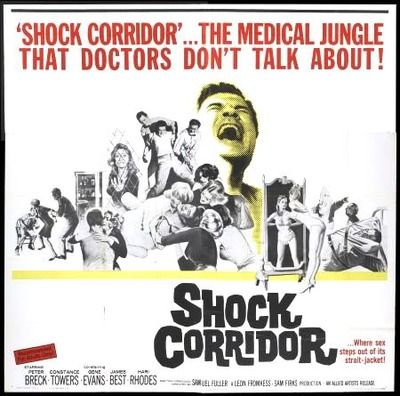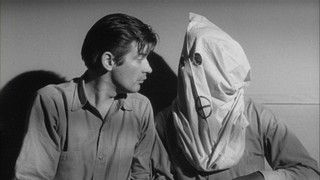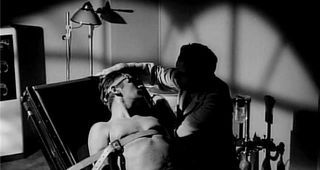
Shock Corridor
1963
Director: Samuel Fuller
Starring: Peter Breck, Constance Towers
Movies like Shock Corridor reinforce in me the notion that giving a picture a second chance is sometimes the best thing in the world. My initial impression of this movie several years ago could be summed up by “halfway decent B picture.” Now I feel as though I have more of a handle on what Samuel Fuller is all about as a writer-director, and seeing Shock Corridor for the second time, I enjoyed it much more.
The slightly hackneyed plot is all about Johnny Barrett (Breck), a reporter willing to do anything it takes to win a Pulitzer Prize. The way he’s planning on getting his hands on it is by coercing his stripper girlfriend Cathy (Towers) into pretending to be his sister, then having her commit him to a mental hospital on the trumped up charges of incestual fetishism. Once there, he can investigate the three mentally disturbed witnesses to a murder at said hospital. Everything goes according to plan, except for the wee little hiccup that Johnny starts to lose his own grasp on reality the more time he spends as a patient.
To me, a Samuel Fuller film means grotesque beauty, great play with high contrast lighting and shadows, uncomfortable situations, and characters who are played to absolute extremes. With that in mind, it makes total sense that Fuller made a movie set in a mental hospital. I can almost feel his giddiness, rubbing his sweaty palms together and giggling at the insanity (pun intended) he’s about to unleash. This attitude just leaps off the screen.
The biggest driving forces of this film are the performances of everyone involved. This being Fuller, the performances are obviously a bit over the top, but what I really liked a lot with Breck’s performance was the clear distinction he made between “Johnny PLAYING at being crazy” and “Johnny ACTUALLY becoming crazy.” The former was easily the hammiest acting of the entire film, but why shouldn’t it be? It was a reporter pretending to be insane; of course he would cheese it up. It was derivative and unoriginal, but it was meant to be exactly that. As Johnny descends into actual madness, the cheeseball nature seems to melt away and we get a much subtler, less obvious performance. Breck has a great deal on his shoulders with this role, and he unabashedly plunges full throttle into his part.

The supporting cast around him is terrific. Towers tears it up as a distraught girlfriend, helplessly watching her loved one fall away from her, but the fact that she’s a stripper and we get to see one of her performances pushes her traditional weeping and wailing into a surreal territory. The three witnesses that Johnny is after all turn in great performances, all three running the gamut from sane and lucid to absolutely raving. One of my favorite inmates was Johnny’s roommate, the obese Pagliacci (played by Larry Tucker). His mental patient persona was more restrained, but also more frightening than the others. You never quite knew what he would do next; he could simply give you a couple of sticks of gum, or he could pretend to kill you.
In terms of the three mental patients that Johnny is investigating, Fuller’s in full-on and unapologetic social commentary mode. The ex-GI whose hateful and bigoted parents helped turn him into a Communist deserter is a heartbreaking and scathing indictment of intolerance in the American South (I pinpoint the South in particular due to the fact that the patient’s hospital persona is that of a Confederate General) as well as getting embroiled in Communist witch hunts. The world class physicist who helped design weapons of mass destruction is now in the hospital having adopted the persona of a six-year-old child. As a scientist myself, that character clearly represents the dangers and plight of ethics and morality in pushing the boundaries of what science could accomplish. We must always be mindful of our capabilities, Fuller is saying. The most shocking of the mental patients is the black patient, the first black student at an integrated school in the South, whose hospital persona is that of a Ku Klux Klan wizard, spewing racial hatred and inducing riots at every opportunity. Forty years later, this character is still deeply unsettling. While we have moved past segregation (thankfully), this character is a potent reminder of our not-so-distant past. It’s a ballsy move.

Fuller plays with the central motif of saying one thing while meaning another time and time again. Most obviously, we have Johnny who is saying and doing all the right things to convince the doctors that he is insane, but really having his journalistic desires in mind. The film even opens on one such scene; Johnny is being asked if he has ever had impure thoughts about his sister. Turns out, Fuller is playing with us; the scene is a rehearsal for Johnny, and not real in the slightest. We are introduced early on to the idea of saying one thing, meaning another. Nearly all the patients in the mental hospital exhibit this at one time or another, as well as the staff. To me, a rather uncomfortable moment of this was when Fuller shows us Cathy’s striptease. There is full on pelvic gyrating; this is not a “classy” or “high brow” striptease; this is utterly vulgar. The only thing keeping Fuller from showing nudity was the still-in-place Hays Code. Ironically, while we are getting this bump-and-grind on, Cathy is singing a sweet song about love. Talk about disjointedness. Her lips are saying “love,” her body is saying “fuck me, and don’t do it nicely.” It really drove home Fuller’s point; you can’t trust a single person in this film.
My least favorite part of the film was the conclusion. To me, the murder investigation is so secondary in this film; it is NOT what Shock Corridor is about. But Fuller makes the murder investigation take the main stage in the finale. I honestly wish that he ended his movie ten minutes before he actually did. Just cut the last ten minutes or so, end the film there, roll credits, and you’d make a pretty strong film so much better. Instead, there’s this protracted focus on who the killer is, which seems silly, because we honestly haven’t cared about the killer for the entire movie. Instead, it’s all about the patients in the hospital and Johnny’s mental journey. I wish Fuller had focused more on that aspect.

You can have black and white photography that seems gauzy and gorgeous and makes everyone appear far more beautiful than they actually are; this is not the black and white photography of Samuel Fuller. Here is a man who delights in highlighting the beads of sweat on his actors’ faces and on making sure that the shadows point out every pock mark and blemish we can possibly see, and man, does he do that here. Lighting is bright and harsh and completely unforgiving, which means that we get very little that is in between: everything is either super white or enveloped in shadow. Typically, Fuller lights his actors from just underneath their faces, giving them a slight monstrosity. It wouldn’t be Fuller if everyone wasn’t a bit grotesque.
Shock Corridor is undoubtedly a B movie – I don’t think Samuel Fuller can make any other kind of movie – but man, is it a great B movie. It’s thrilling and gaudy. It’s balls to the walls from start to finish, and it’s hella fun.
Arbitrary Rating: 8/10
Love this one. It's just so lurid. You're right about the striptease, too--made a few years later, that would involve full nude pelvic thrusting a la Showgirls.
ReplyDeleteIt always feels like Fuller chances into things--that his great statements happen not by design but because the pieces just fell that way. However, it happens so often for him that it's either by design or he's the luckiest mo-fo to ever stand next to a camera.
Oh yeah, the more I watch Fuller, the more I love that, well, lurid style of his, if I may co-opt your word.
DeleteAlthough I think Fuller certainly has talent, I also think he had a little bit of luck in his corner as well. There is a bit of shoddy camerawork every now and then - I saw a boom mike in a mirror - which makes the film feel as if it was hastily slapped together. But the thing is, Fuller seems to have such a strong sense of what he wants, that even if it IS a little hastily mashed up, it's still great stuff.